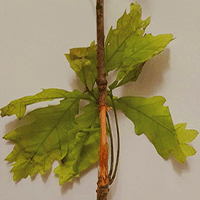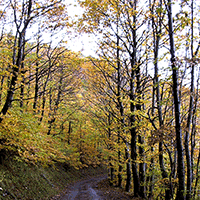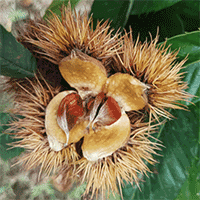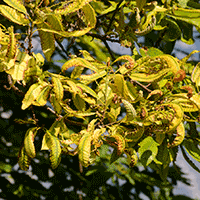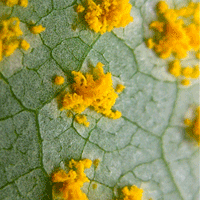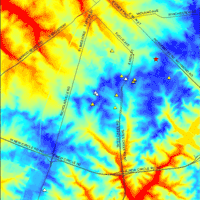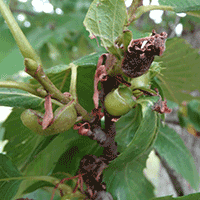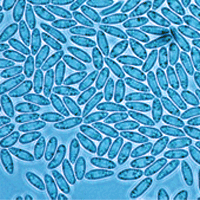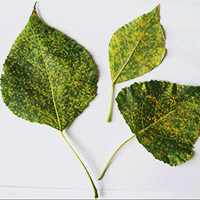The presence of Cryphonectria parasitica on sessile oak (Quercus petraea) requires comprehensive research to understand how this fungus spreads. An experiment was conducted to investigate the impact of C. parasitica on different sessile oak stands. The experiment involved inoculating 2-year-old seedlings from 12 different half-sib lines. After 50 days, the results showed a significant difference in dieback, mortality, and dimensions of necrotic lesions among the 2-year-old sessile oak seedlings from different half-sib lines. Mortality dieback rates varied from 20% to 80% across the different half-sib lines. Seedlings from one half-sib line (8.33%) had the smallest length of necrotic lesions and the lowest dieback percentage, while seedlings from four half-sib lines (33.33%) had the narrowest width of necrotic lesions. Unlike other seedlings, the half-sib lines with smaller necrotic lesions did not experience mortality. Sessile oak seedlings’ smaller diameter and height influenced the development of narrower necrotic lesions. For the first time, this study demonstrated the potential for selecting mother trees to produce sessile oak seedlings tolerant to Cryphonectria parasitica. It also suggested that seedling dimensions can be used to indicate their sensitivity to the fungus.
Keywords
, , ,
Citation
Vemić A, Lučić A, Radulović Z, Jovanović S, Rakonjac L, Popović V (2025). Effect of origin and morphological characteristics of sessile oak (Quercus petraea) seedlings on the development of Cryphonectria parasitica. iForest 18: 16-22. - doi: 10.3832/ifor4669-017
Academic Editor
Alberto Santini
Paper history
Received: Jun 20, 2024
Accepted: Dec 05, 2024
First online: Feb 15, 2025
Publication Date: Feb 28, 2025
Publication Time: 2.40 months
© SISEF - The Italian Society of Silviculture and Forest Ecology 2025
Open Access
This article is distributed under the terms of the Creative Commons Attribution-Non Commercial 4.0 International (https://creativecommons.org/licenses/by-nc/4.0/), which permits unrestricted use, distribution, and reproduction in any medium, provided you give appropriate credit to the original author(s) and the source, provide a link to the Creative Commons license, and indicate if changes were made.

Breakdown by View Type
(Waiting for server response...)
Article Usage
Total Article Views: 5648
(from publication date up to now)
Breakdown by View Type
HTML Page Views: 1992
Abstract Page Views: 1571
PDF Downloads: 1882
Citation/Reference Downloads: 0
XML Downloads: 203
Web Metrics
Days since publication: 277
Overall contacts: 5648
Avg. contacts per week: 142.73
Article Citations
Article citations are based on data periodically collected from the Clarivate Web of Science web site
(last update: Mar 2025)
(No citations were found up to date. Please come back later)
Publication Metrics
by Dimensions ©
Articles citing this article
List of the papers citing this article based on CrossRef Cited-by.
(1)
Akilli Simsek C, Akyüz B, Katircioglu YZ, Serdar U, Maden S (2020)Effectiveness and efficacy of superficial disinfectants to prevent mechanical transmission of
Cryphonectria parasitica from chestnut scion woods. European Journal of Plant Pathology 159: 131-138.
CrossRef |
Gscholar
(2)
Allemann C, Hoegger P, Heiniger U, Rigling D (1999)Genetic variation of
Cryphonectria hypoviruses (CHV1) in Europe assessed using restriction fragment length polymorphism (RFLP) markers. Molecular Ecology 8 (5): 843-854.
CrossRef |
Gscholar
(3)
Celiker NM, Kaplan C, Onogur EE, Cetinel B, Poyraz D, Uysal A (2017)Natural dissemination of hypovirulent
Cryphonectria parasitica strain used for biological control of chestnut blight. Turkish Journal of Agriculture and Forestry 41 (4): 278-284.
CrossRef |
Gscholar
(4)
Crainic GC, Sicoe SI, Irimie F, Irimie Cioflan F, Iovan CI, Bodog MF (2023)The particularities of the ecological rehabilitation works of the sessile oak stands (
Quercus petraea (Matt.) Liebl.) from the seed reserve. Scientific Papers Series E: Land Reclamation, Earth Observation and Surveying, Environmental Engineering, Vol. 12, pp. 224-235.
Online |
Gscholar
(5)
Dallavalle E, Zambonelli A (1999)Epidemiological role of
Cryphonectria parasitica isolated from hosts other than chestnut. European Journal of Forest Pathology 29 (2): 97-102.
CrossRef |
Gscholar
(6)
Dennert F, Meyer JB, Rigling D, Prospero S (2019)Assessing the phytosanitary risk posed by an intraspecific invasion of
Cryphonectria parasitica in Europe. Phytopathology 109 (12): 2055-2063.
CrossRef |
Gscholar
(7)
Dennert F, Rigling D, Meyer JB, Schefer C, Augustiny E, Prospero S (2020)Testing the pathogenic potential of
Cryphonectria parasitica and related species on three common European Fagaceae. Frontiers in Forests and Global Change 3: 443.
CrossRef |
Gscholar
(8)
Eaton E, Caudullo G, Oliveira S, De Rigo D (2016)Quercus robur and
Quercus petraea in Europe: distribution, habitat, usage and threats. In: “European Atlas of Forest Tree Species” (San-Miguel-Ayanz J, de Rigo D, Caudullo G, Houston Durrant T, Mauri A eds). Publications Office of the European Union, Luxembourg, pp. e01c6df.
Online |
Gscholar
(9)
EFSA/PLH (2014)Scientific opinion on the pest categorisation of
Cryphonectria parasitica (Murrill) Barr. EFSA Panel on Plant Health - PLH, EFSA Journal 12 (10): 3859.
Gscholar
(10)
Enebak SA, MacDonald WL, Hillman BI (1994)Effect of dsRNA associated with isolates of
Cryphonectria parasitica from the central Appalachians and their relatedness to other dsRNAs from North America and Europe. Phytopathology 84 (5): 528-534.
CrossRef |
Gscholar
(11)
Fodor E, Hruta O (2016)Quercus robur,
Q. cerris and
Q. petraea as hot spots of biodiversity. Journal of Plant Development 23: 187-210.
Online |
Gscholar
(12)
Gryzenhout M, Wingfield BD, Wingfield MJ (2009)Taxonomy, phylogeny, and ecology of bark-inhabiting and tree-pathogenic fungi in the Cryphonectriaceae. American Phytopathological Society Press, Saint Paul, MN, USA, pp. 136. -
Online |
Gscholar
(13)
Havir EA, Anagnostakis SL (1983)Oxalate production by virulent but not by hypovirulent strains of
Endothia parasitica. Physiological Plant Pathology 23 (3): 369-376.
CrossRef |
Gscholar
(14)
Hillman I, Suzuki N (2004)Viruses of the chestnut blight fungus,
Cryphonectria parasitica. Advances in Virus Research 63: 423-472.
CrossRef |
Gscholar
(15)
Hoegger PJ, Heiniger U, Holdenrieder O, Rigling D (2003)Differential transfer and dissemination of hypovirus and nuclear and mitochondrial genomes of a hypovirus-infected
Cryphonectria parasitica strain after introduction into a natural population. Applied and Environmental Microbiology 69 (7): 3767-3771.
CrossRef |
Gscholar
(16)
Jezić M, Krstin Lj Rigling D, Curković-Perica M (2012)High diversity in populations of the introduced plant pathogen,
Cryphonectria parasitica, due to encounters between genetically divergent genotypes. Molecular Ecology 21 (1): 87-99.
CrossRef |
Gscholar
(17)
Jezić M, Mlinarec J, Vuković R, Katanić Z, Krstin Lj Nuskern L, Poljak I, Idzojtić M, Tkalec M, Curković-Perica M (2018)Changes in
Cryphonectria parasitica populations affect natural biological control of chestnut blight. Phytopathology 108 (7): 870-877.
CrossRef |
Gscholar
(18)
Jung T, Orlikowski L, Henricot B, Abad-Campos P, Aday AG, Aguín Casal O, Bakonyi J, Cacciola SO, Cech T, Chavarriaga D, Corcobado T, Cravador A, Decourcelle T, Denton G, Diamandis S, Dogmus-Lehtijärvi HT, Franceschini A, Ginetti B, Green S, Glavendekić M, Hantula J, Hartmann G, Herrero M, Ivic D, Horta Jung M, Lilja A, Keca N, Kramarets V, Lyubenova A, Machado H, Magnano di San Lio G, Mansilla Vázquez PJ, Marçais B, Matsiakh I, Milenkovic I, Moricca S, Nagy ZÁ, Nechwatal J, Olsson C, Oszako T, Pane A, Paplomatas EJ, Pintos Varela C, Prospero S, Rial Martínez C, Rigling D, Robin C, Rytkönen A, Sánchez ME, Sanz Ros AV, Scanu B, Schlenzig A, Schumacher J, Slavov S, Solla A, Sousa E, Stenlid J, Talgø V, Tomic Z, Tsopelas P, Vannini A, Vettraino AM, Wenneker M, Woodward S, Peréz-Sierra A (2016)Widespread
Phytophthora infestations in European nurseries put forest, semi-natural and horticultural ecosystems at high risk of
Phytophthora diseases. Forest Pathology 46 (2): 134-163.
CrossRef |
Gscholar
(19)
Kanjevac B, Krstić M, Babić V, Govedar Z (2021)Regeneration dynamics and development of seedlings in sessile oak forests in relation to the light availability and competing vegetation. Forests 12 (4): 384.
CrossRef |
Gscholar
(20)
Karadzić D, Milenković I, Milanović S, Golubović Curguz V, Tomović Z (2017)Najznačajnije parazitske i saprofitske gljive u hrastovim šumama na području JP “Vojvodinašume” [The most important parasitic and saprophytic fungi in oak forests in the area of PE “Vojvodinasume”. PE “Vojvodinasume”, Petrovaradin, Serbia, pp. 154. [in Serbian]
Gscholar
(21)
Karadzić D, Radulović Z, Sikora K, Stanivuković Z, Golubović Curguz V, Oszako T, Milenković I (2019)Characterisation and pathogenicity of
Cryphonectria parasitica on sweet chestnut and sessile oak trees in Serbia. Plant Protection Science 55 (3): 191-201.
CrossRef |
Gscholar
(22)
Kohler M, Pyttel P, Kuehne C, Modrow T, Bauhus J (2020)On the knowns and unknowns of natural regeneration of silviculturally managed sessile oak (
Quercus petraea (Matt.) Liebl.) forests a literature review. Annals of Forest Science 77: 101.
CrossRef |
Gscholar
(23)
Kumbasli M, Makineci E, Keten A, Beskardes V, Ozdemir E (2017)Effects of parent material, stand type and oak species on defoliation of coppice-originated oak (
Quercus spp.) forests in Northern Turkish Thrace. Bosque 38 (2): 299-306.
CrossRef |
Gscholar
(24)
Kunova A, Pizzatti C, Cerea M, Gazzaniga A, Cortesi P (2017)New formulation and delivery method of
Cryphonectria parasitica for biological control of chestnut blight. Journal of Applied Microbiology 122 (1): 180-187.
CrossRef |
Gscholar
(25)
Lawson SS, Ebrahimi A, McKenna JR (2021)Differing responses to
Cryphonectria parasitica at two Indiana locations. Forests 12 (6): 794.
CrossRef |
Gscholar
(26)
Lione G, Brescia F, Giordano L, Gonthier P (2022)Effects of seasonality and climate on the propagule deposition patterns of the chestnut blight pathogen
Cryphonectria parasitica in orchards of the Alpine district of North Western Italy. Agriculture 12 (5): 644.
CrossRef |
Gscholar
(27)
Lione G, Giordano L, Turina M, Gonthier P (2020)Hail-induced infections of the chestnut blight pathogen
Cryphonectria parasitica depend on wound size and may lead to severe diebacks. Phytopathology 110 (7): 1280-1293.
CrossRef |
Gscholar
(28)
Lovat C-A, Donnelly DJ (2019)Mechanisms and metabolomics of the host-pathogen interactions between Chestnut (
Castanea species) and Chestnut blight (
Cryphonectria parasitica). Forest Pathology 49 (6): e12562.
CrossRef |
Gscholar
(29)
Milenković I (2015)Diversity of species from the
Phytophthora genus and their role in the decline of broadleaved forest trees in Serbia. PhD Thesis, University of Belgrade, Faculty of Forestry, Serbia, pp. 240.
Gscholar
(30)
Milgroom MG, Cortesi P (2004)Biological control of chestnut blight with hypovirulence: a critical analysis. Annual Review of Phytopathology 42: 311-338.
CrossRef |
Gscholar
(31)
Nash BL, Stambaugh WJ (1982)Disease incidence, symptomology, and vegetative compatibility type distribution of Endothia parasitica on oak and chestnut hosts in North Carolina. In: Proceedings of the “USDA Forest Service American Chestnuts Cooperators’ Meeting” (Smith HC, MacDonald WL eds). West Virginia University, Morgantown, WV, USA, pp. 74-82.
Gscholar
(32)
Nuss DL, Hillman BI, Rigling D, Suzuki N (2005)Family Hypoviridae. In: “Virus Taxonomy - Eighth Report of the International Committee on Taxonomy of Viruses” (Fauquet CM, Mayo M, Maniloff J, Desselberger U, Ball LA eds). Elsevier, Academic Press, Cambridge, MA, USA pp. 597-601.
Gscholar
(33)
Old KM, Kobayashi T (1988)Eucalypts are susceptible to the chestnut blight fungus,
Cryphonectria parasitica. Australian Journal of Botany 36 (5): 599-603.
CrossRef |
Gscholar
(34)
Ozden Keles S, Unal S, Akan S, Karadeniz M (2024)Chestnut blight (
Cryphonectria parasitica (Murr.) Barr) disease incidence and its effect on the morphological and anatomical features of
Castanea sativa trees. Forest Pathology 54 (1): e12843.
CrossRef |
Gscholar
(35)
Prospero S, Rigling D (2013)Chestnut blight. In: “Infectious Forest Diseases” (Gonthier P, Nicolotti G eds). CAB International, Wallingford, UK, pp. 318-329. -
Online |
Gscholar
(36)
Radócz L, Tarcali G, Jenei A (2010)In vitro susceptibility of different oak species to the blight fungus (
Cryphonectria parasitica). Acta Horticulturae 866: 455-458.
CrossRef |
Gscholar
(37)
Rigling D, Prospero S (2018)Cryphonectria parasitica, the causal agent of chestnut blight: invasion history, population biology and disease control. Molecular Plant Pathology 19 (1): 7-20.
CrossRef |
Gscholar
(38)
Roane MK, Griffin GJ, Elkins JR (1986)Chestnut blight, other
Endothia diseases, and the genus
Endothia. American Phytopathological Society Press, Saint Paul, MN, USA, pp. 53. -
Online |
Gscholar
(39)
Romon-Ochoa P, Forster J, Chitty R, Gorton C, Lewis A, Eacock A, Kupper Q, Rigling D, Pérez-Sierra A (2022)Canker development and biocontrol potential of CHV-1 infected English isolates of
Cryphonectria parasitica is dependent on the virus concentration and the compatibility of the fungal inoculums. Viruses 14 (12): 2678.
CrossRef |
Gscholar
(40)
Romon-Ochoa P, Smith O, Lewis A, Kupper Q, Shamsi W, Rigling D, Pérez-Sierra A, Ward L (2023)Temperature effects on the
Cryphonectria hypovirus 1 accumulation and recovery within its fungal host, the chestnut blight pathogen
Cryphonectria parasitica. Viruses 15 (6): 1260.
CrossRef |
Gscholar
(41)
Spiecker H (2021)Production of valuable oak wood in Europe. Annals of Forest Research 64 (1): 5-1.
CrossRef |
Gscholar
(42)
Stauber L, Prospero S, Croll D (2020)Comparative genomics analyses of lifestyle transitions at the origin of an invasive fungal pathogen in the genus
Cryphonectria. mSphere 5 (5): e00737-20.
CrossRef |
Gscholar
(43)
Tarcali G, Radócz L, Jenei A, Tóth J (2009)Bark reaction of different oak species to
Cryphonectria parasitica. Acta Horticulturae 844: 433-438.
CrossRef |
Gscholar
(44)
Tkaczyk M (2023)Worldwide review of bacterial diseases of oaks (
Quercus sp.) and their potential threat to trees in Central Europe. Forestry 96 (4): 425-433.
CrossRef |
Gscholar
(45)
Tkaczyk M, Sikora K, Galko J, Kunca A, Milenković I (2020)Isolation and pathogenicity of
Phytophthora species from sessile oak (
Quercus petraea (Matt.) Liebl.) stands in Slovakia. Forest Pathology 50 (5): e12632.
CrossRef |
Gscholar
(46)
Trenyik P, Skutai J, Szirmai O, Czóbel S (2018)Instrumental analysis of health status of
Quercus petraea stands in the Carpathian Basin. Central European Forestry Journal 65 (1): 34-40.
CrossRef |
Gscholar
(47)
Turchetti T, Maresi G, Santagada A (1991)Attacchi di
Cryphonectria parasitica (Murr.) Barr su differenti ospiti nel Cilento [Attacks of
Cryphonectria parasitica (Murr.) Barr on different hosts in Cilento]. Monti e Boschi 5: 54-58. [in Italian]
Gscholar
(48)
Witte TE, Shields S, Heberlig GW, Darnowski MG, Belov A, Sproule A, Boddy CN, Overy DP, Smith ML (2021)A metabolomic study of vegetative incompatibility in
Cryphonectria parasitica. Fungal Genetics and Biology 157 (7): 103633.
CrossRef |
Gscholar
